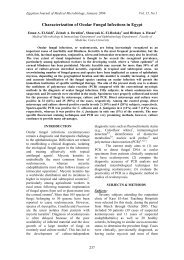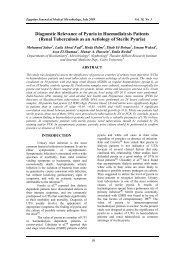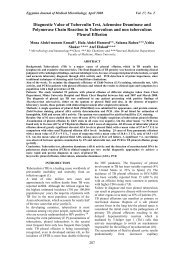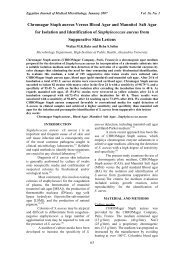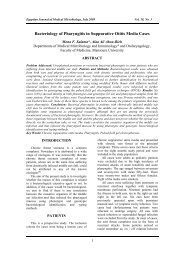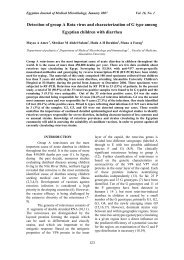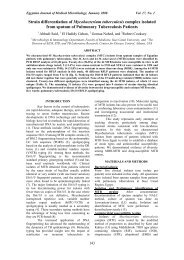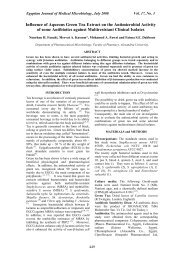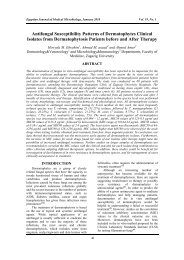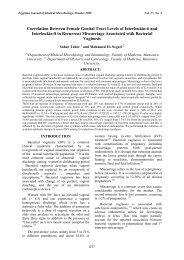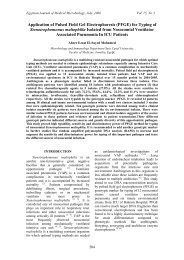Evaluation of the Antimicrobial and Cytotoxic Activity of Epiphany ...
Evaluation of the Antimicrobial and Cytotoxic Activity of Epiphany ...
Evaluation of the Antimicrobial and Cytotoxic Activity of Epiphany ...
You also want an ePaper? Increase the reach of your titles
YUMPU automatically turns print PDFs into web optimized ePapers that Google loves.
Egyptian Journal <strong>of</strong> Medical Microbiology, January 2007 Vol. 16, No. 1<br />
particular, it had a moderate effect on<br />
E.faecalis.<br />
The antimicrobial activity <strong>of</strong> Ketac-<br />
Endo is assumed to rely on fluoride ion<br />
release, but <strong>the</strong> quantities <strong>of</strong> fluoride released<br />
may not be sufficient to reach a concentration<br />
that effectively kills microorganisms 30. A<br />
weak antimicrobial activity <strong>of</strong> Ketac-Endo<br />
has been reported by Heling <strong>and</strong> Ch<strong>and</strong>ler 31.<br />
<strong>Antimicrobial</strong> activity <strong>of</strong> root<br />
canal sealers helps destroy <strong>the</strong> remaining<br />
bacteria. On <strong>the</strong> o<strong>the</strong>r h<strong>and</strong>, severe toxicity <strong>of</strong><br />
a filling material may be a reason for damage<br />
<strong>of</strong> <strong>the</strong> periapical tissue <strong>the</strong>reby abolishing <strong>the</strong><br />
beneficial effects <strong>of</strong> <strong>the</strong> antimicrobial<br />
properties <strong>of</strong> <strong>the</strong> material<br />
22 . The<br />
antimicrobial components <strong>of</strong> <strong>the</strong> sealer do not<br />
have selective toxicity against<br />
microorganisms; <strong>the</strong>y also exert toxic effects<br />
on host cells 31 .<br />
Azar, et al 32 thought that in general,<br />
<strong>the</strong> toxicity <strong>of</strong> newly developed materials<br />
should be assessed using <strong>the</strong> three steps<br />
approach. A first step is to screen a c<strong>and</strong>idate<br />
material using a series <strong>of</strong> in vitro cytotoxicity<br />
assays using cell cultures. Then, if <strong>the</strong><br />
material is determined not to be cytotoxic in<br />
vitro, it can be implanted in subcutaneous<br />
tissue or muscle <strong>and</strong> <strong>the</strong> local tissue reaction<br />
evaluated. Finally, <strong>the</strong> in vivo reaction <strong>of</strong> <strong>the</strong><br />
target tissue versus <strong>the</strong> test material must be<br />
evaluated in human subjects or animals.<br />
Therefore, if <strong>the</strong> test material induces a strong<br />
cytotoxic reaction in cell culture tests, it is<br />
very likely also to exert toxicity in living<br />
tissue. A reduction in <strong>the</strong> number <strong>of</strong> animal<br />
tests <strong>and</strong> <strong>the</strong> resulting expenses might be an<br />
additional benefit <strong>of</strong> such a screening<br />
approach.<br />
In this study, <strong>the</strong> cytotoxicity was<br />
evaluated by measuring <strong>the</strong> cell growth via<br />
cell counting. This method was chosen<br />
because it is easy, not requiring complicated<br />
or expensive equipments.<br />
In this present study, an in vitro<br />
cytotoxicity tests was done by using primary<br />
cells, mainly oral fibroblasts, to test <strong>the</strong> dental<br />
materials. Primary cell lines have a<br />
predetermined life span <strong>and</strong> will eventually<br />
reach a plateau <strong>of</strong> growth <strong>and</strong> <strong>the</strong>n die even if<br />
<strong>the</strong> conditions for growth are acceptable.<br />
Because <strong>the</strong> materials tested would more<br />
likely come into contact with human<br />
fibroblasts in vivo, <strong>the</strong>y were chosen to more<br />
closely represent clinical conditions 33<br />
This study showed that <strong>the</strong><br />
<strong>Epiphany</strong> root canal sealer was less toxic than<br />
AH-26 <strong>and</strong> Ketac-Endo, <strong>the</strong> values <strong>of</strong> <strong>the</strong><br />
cytotoxicity <strong>of</strong> <strong>Epiphany</strong> were not significant<br />
when compared to EndoFill <strong>and</strong> Apexit.<br />
These results are in agreement with Souza et<br />
al34 who showed that <strong>Epiphany</strong> root canal<br />
sealer was <strong>the</strong> only material that presented<br />
intraosseous biocompatibility compared to<br />
AH Plus <strong>and</strong> EndoRez.<br />
On <strong>the</strong> contrary, Susini14 et al<br />
showed that <strong>Epiphany</strong> + Resilon were <strong>the</strong><br />
most cytotoxic material at 1 <strong>and</strong> 2 days <strong>and</strong><br />
this toxicity decreases with time until become<br />
nontoxic at 7 days. They explained this<br />
toxicity to be due to leaching <strong>of</strong> uncured<br />
monomers from <strong>the</strong> bulk <strong>of</strong> <strong>the</strong> resin because<br />
<strong>Epiphany</strong> set under anaerobic conditions <strong>and</strong><br />
no curing system leads to a 100% <strong>of</strong><br />
conversion 35.<br />
The results <strong>of</strong> this study concerning<br />
<strong>the</strong> ZOE sealer were similar to previous<br />
findings that showed that this material is<br />
moderately toxic <strong>and</strong> this toxicity is attributed<br />
to <strong>the</strong> release <strong>of</strong> free eugenol which is <strong>the</strong><br />
main liquid components <strong>of</strong> ZOE based<br />
sealers 36, 37. It is interesting to know that<br />
when zinc oxide eugenolate is formed, most<br />
<strong>of</strong> <strong>the</strong> free eugenol is bound which account<br />
for <strong>the</strong> relatively low toxicity <strong>of</strong> ZOE based<br />
sealers in <strong>the</strong> initial setting reaction 38 .<br />
However, after 48h enough free eugenol<br />
escaped to cause <strong>the</strong> reaction to become<br />
predominantly severe 39 .<br />
This study indicated that AH-26<br />
had a moderate to severe cytotoxic reaction<br />
immediately after mixing <strong>and</strong> this toxicity<br />
decreased after 24h. These effects may be due<br />
to formaldehyde, which is released during <strong>the</strong><br />
initial setting reaction. It has been<br />
demonstrated that AH-26 is relatively<br />
38-40<br />
cytotoxic sealer as it releases<br />
formaldehyde during <strong>and</strong> after setting 39 .<br />
Periapical inflammatory reactions were<br />
detected when AH-26 was used as sealer 42 .<br />
Ketac-Endo showed a pronounced<br />
cytotoxic effect in <strong>the</strong> early phase <strong>of</strong> <strong>the</strong><br />
setting reaction <strong>and</strong> this toxicity decreased<br />
after 24h. This observation is in agreement<br />
with a previous study which showed strong<br />
inflammatory reactions caused by Ketac-Endo<br />
40 . Schwarze 36 et al. explained this toxicity by<br />
<strong>the</strong> high water solubility <strong>of</strong> <strong>the</strong> glass ionomer<br />
cement in <strong>the</strong> early phase <strong>of</strong> <strong>the</strong> setting<br />
101



